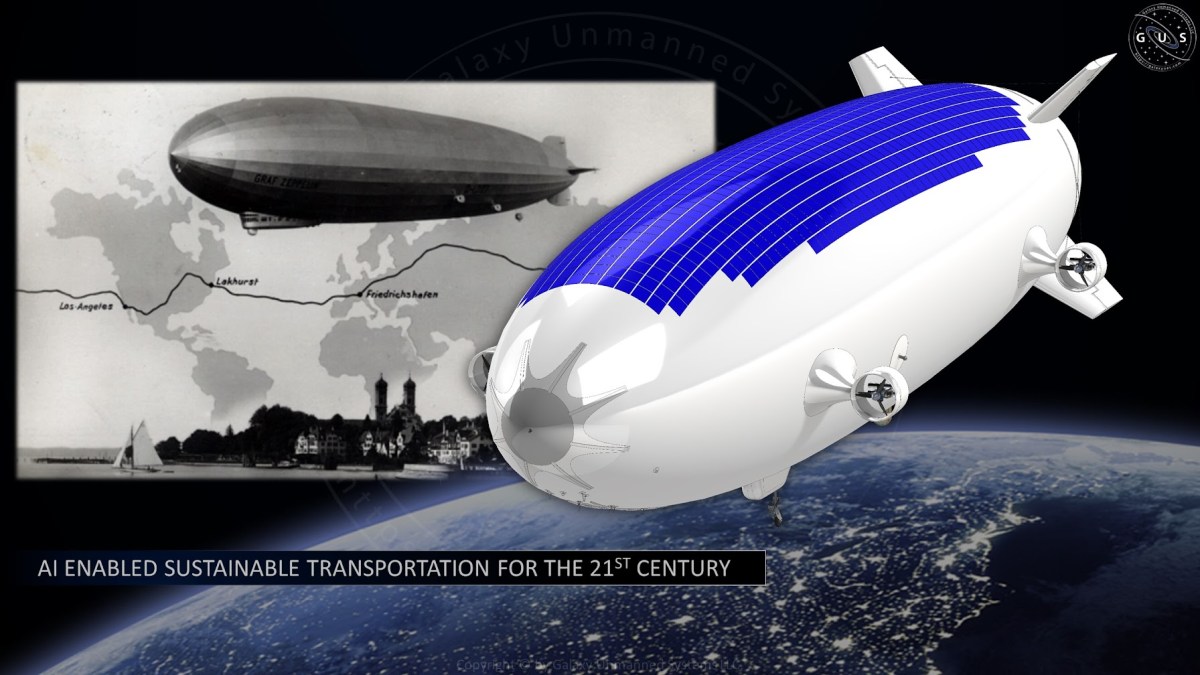Fort Worth-based Galaxy Unmanned Systems LLC (GUS) aims to chase the historical first circumnavigation of the world by airship completed one hundred years ago. We are rapidly approaching the historical centennial of National Geographic Society Gold Medal Winner Hugo Eckener for his achievement of piloting the first airship flight around the world at the helm of the famous Graf (Count) Zeppelin (LZ-127).
Now, one-hundred years later, with advancements in technology, GUS envisions an autonomous airship that will circumnavigate the globe with our AIrship Discovery. In this instance we plan do the same without human intervention, with an estimated launch date of August 8 th , 2029.
The autonomous airship engineering will aspire for a self-sustaining system, harnessing the synergy of hydrogen fuel cells and solar panels for power generation, complemented by electrolyzers for hydrogen production from water—a byproduct of our power generation process. Passive water accumulators will capture environmental moisture, ensuring an endless supply of this crucial resource and propelling us toward our goal of perpetual flight.
This airship’s propulsion and lift generation mechanisms are sustainable, eco-friendly, and green innovation focused. With all-electric motors and a lift system that transitions from helium to hydrogen for increased efficiency and to compensate for lift gas loss, we are creating a fully self-replenishing system as a proof-of-concept model for sustainable aviation.
The added level of complexity with an unmanned Galaxy Airship (whatever we are calling it. This could be a contest or naming sponsorship.) Whatever we are calling it isn’t just any airship, as the yet-to-be-determined Galaxy GC-??. The ultimate design, power and autopilot as of yet remain undetermined as the design parameter algebra will hinge on the end goal of the project and will have to factor in hardware and software engineering solutions to overcome the environmental conditions.
This design represents a culmination of more than sixty years of experience in unmanned Lighter-Than-Air (LTA) research and development work proven in the field by company principals.
We can do it! Many unmanned first including the first HD broadcast (GC60-G2A) were achieved by Galaxy principals in a time when FAA regulations allowed for rapid innovation of unmanned aircraft systems. The ‘Spirt of Dallas’ Galaxy GS75-G2A was, until that time, the largest civilian unmanned airship ever built, boasting an envelope capacity of 12K cubic feet of helium, producing 802 pounds of gross aerostatic lift!
Those designs and systems all built and flown in the Texas DFW metroplex. GUS aims to embrace this new Round the World challenge with existing and near future technology partners working together towards sustainable electric aviation. Galaxy
Unmanned Systems GUS works on several dual-use AFWERX /US Army contracts ($3.25 million https://www.sbir.gov/node/1612601) contracts to validate Advanced Air Mobility and airspace integration concepts. With the help of our academic and business research contract partners, we are pushing the boundaries of what is possible in aerial mobility, embodied in the GUS Constellation Concept. Some of this work is partially validated and embodied in our Persistent Airborne Laboratory, or PAL concept. And yes,the Persistent nomenclature is aspirational, as we are still bound by the laws of physics and natural philosophy. However, that doesn’t preclude us from pressing the many benefits inherent in aerostatic lift (buoyancy) into service, carefully coloring up to the line, if you will, of the second law of thermodynamics.
These innovative technologies and forward-reaching approach create a self-sustaining, autonomous airships capable of complex, adaptive behaviors powered by advanced AI and machine learning algorithms. This dynamic system will feature a regenerative power management subsystem that harnesses hydrogen fuel cells and solar energy, this ambient fuel source forms the backbone of our vision for a new era of sustainable aviation.
Keep up with the progress of the design, build, and flight of the Around-The-World historic flight slated for launch on August 8th, 2029, here

